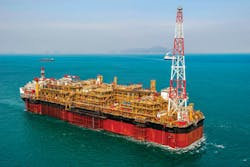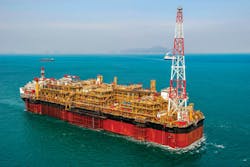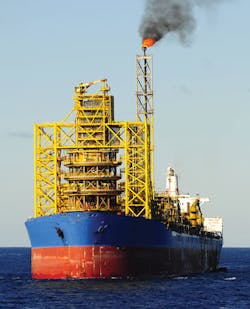Industry grapples with use of composite material to repair FPUs
New pilot program will provide guidance on applications
Christiane Machado
ABS
Renewing degraded steel structures on floating production units (FPU) often requires cutting and welding, and in many cases, necessitates the use of temporary support structures. This repair approach presents risks.
While there are ways to reduce the risks inherent to traditional approaches to steel renewal, there is no way to eliminate them. However, an alternative repair approach using composite material bonded to existing structures could provide reliable results while at the same time mitigating risk.
The oil and gas industry is beginning to evaluate procedures and solutions for repairing steel structures - including piping and equipment - using composites. At present, there are no standards in place for carrying out composite repairs dedicated to the offshore environment and no training guidelines for the personnel who will perform the work. There also is a lack of guidance for engineering and third-party survey teams that will be called upon to conduct design review, witness fabrication, survey installations, and monitor repairs. Implementing a solution of this type carries with it the need to create a catalogue of acceptable typical composite repairs for FPUs that includes materials and application procedures.
History
Composite materials are created through the artificial combination of materials that have different mechanical and chemical properties. The resulting new material - made of two or more different material types - can be designed to achieve properties that the individual components cannot deliver separately.
Other industries, like aerospace and automotive, have used composites for repairs since 1940. Composites were introduced to the oil and gas industry in the 1950s, with the first application on filament-wound fiberglass pipe. Using composites for repairs was not pursued again by the offshore industry until a few years ago when it became apparent that alternative approaches to repair could be advantageous.
The cost of controlling and/or inhibiting corrosion caused by biological and chemical contaminants has increased substantially. This has led to an interest in exploring new approaches to maintenance and repair, which has opened the door again for considering composite components, with their low weight-strength ratio, good corrosion resistance, and the ability to withstand aggressive marine environments for long periods of time.
While in some cases, the cost of an individual composite component is greater than that of an equivalent metal replacement, when the total cost of handling and installation is factored in, using composites often is more economical than using conventional steel.
Industry needs
The use of composites for repair service is not limited to structures. It also is being considered for application in piping systems, pressure vessels and other equipment on aging FPSOs.
In Brazil, operators have voiced a need for cold repair guidelines. In workshops and conferences around the world, owners and operators have broached this same subject, voicing the desire for classification societies to accept the use of composites on offshore units and requesting guidelines and requirements for acceptance.
Responding to the industry’s need for guidance, ABS began evaluating the use of composites for steel repair, examining how composites and steel of different ages and degradations work. Studies have intensified in the last two years, with a research and development project team in the Brazil Offshore Technology Center looking into composite repair options in Brazil, where a significant number of ABS-classed units are working.
The research team investigated the steps necessary for considering composite repairs as a standard solution for temporary and/or permanent repairs on offshore assets.
One of the primary challenges in using composites is uncertainty about the long-term behavior of two different materials that are functioning as a single piece. This uncertainty can significantly impact engineering review results; so an effort was made to focus on establishing conditions for application in stationary offshore units.
Studies focused on the engineering design methodology for the composite itself, its behavior when integrated with a degraded piece of steel, and installation, monitoring and maintenance actions needed to verify repair integrity and adequacy over the offshore unit’s service life. The study considered engineering review and materials proposed by oil and gas industry service providers with the goal of deriving a feasible methodology.
To have a true idea of how composites would perform on a working asset, the engineering team concluded that the best approach would be to monitor composite repairs to determine if they would require special maintenance. The team approached offshore asset operators and service providers that agreed to partner in a composite repair survey and maintenance program.
Some of the important considerations being addressed in this program are:
- The type of asset (with the trial limited to FPSOs, but with the possibility of adding other asset types in the next phase)
- The type and location of components (structure pieces or piping spools)
- The range of sizes that feasibly can be used for repairs (plate dimensions and percentage of degradation)
- What composite materials can be used
- Installation procedures that will need to be followed.
New procedures
Two new procedures have been derived from this study. One procedure is for composite repairs on steel pipes on floating production installations (FPI), and the other is for composite repairs on steel structures on FPIs.
The procedure for repairs on piping systems were developed based on ASME PCC-2 and ISO 14817:2015 standards that were adapted to fit an offshore inspection and survey scenario. The team defined limitations of applications for use on both temporary and permanent repairs.
Some new constraints were established for permanent repairs, and specific requirements were set up for annual inspections of monitoring systems. Sensor output data would be submitted for review by the classification society. The engineering review process called for a general procedure for executing and maintaining composite piping repairs for the offshore unit along with a specific databook/document for each of the repairs that would be approved by the engineering team and surveyed throughout the unit’s service life.
Following these guidelines, emergency repairs could be performed as a temporary fix, and after subsequent review and approval by the engineering team, could become permanent solutions.
Proving the concept
Since there is no current standard in place for structural repairs using composites, and because of the large range of possible loads and modes of failure that could impact each of the structural pieces, it is difficult to outline a simplified approach to designing a composite repair for structures.
To tackle this challenge, ABS, supported by its partners in this initiative, developed a methodology to adapt standard finite element (FE) models for design and conversion of offshore units into more refined finite models, capable of describing the non-linear effects of composite materials. The result is that numeric non-linear structural analysis can be performed to simulate stress distribution and the load transfer mechanism along existing structures and composite repairs with a higher level of confidence.
The methodology establishes criteria for simulating stress distribution at the location of the bonded repair and along the base material and the composite layers of the repaired structure.
Two scenarios were investigated to define permanent repair acceptance and intervals for inspection. One evaluated an asset with a degraded condition without a composite. This scenario focuses on verifying the condition of a steel structure before repair, identifying any plastification and the likelihood of further occurrence if the installed composite repair were to debond from the steel during unit’s service life. The other evaluated the structure repair using a composite. This scenario covered the verification of the composite/steel structure condition following repair, noting that the verification should demonstrate that the stress distribution was enhanced such that the original design levels of acceptance and safety factors were restored.
Using this approach would allow most of the uncertainty related to the use of composites and steel - the adhesion of composite to steel - to be overcome by analyzing the consequences of a debonding.
To test the recently developed guidelines, ABS formed a partnership with offshore unit operators and service providers to implement these procedures for permanent repairs. Over the last two years, the ABS office in Rio de Janeiro approved two service providers for composite repairs.
Success in Brazil has led to composite repair service providers around the world expressing interest in partnering in pilot programs that will demonstrate their ability to design and install a long-term repair that will perform for 10 years and longer.
The procedure for structural repair has been followed on two units - one several years ago and the other very recently. These two units were investigated under pilot programs in which temporary reinforcement was applied on exposed areas and void spaces to evaluate adherence to the structure.
To date, the process has not been applied to piping systems because service providers are still working to approve their material for permanent use. A pilot program has recently been concluded that will allow composite repairs on several FPSOs in the near future. Results of this initiative are expected to lead to several composite piping repairs being approved and installed by mid-2017.
Additional discussions are ongoing about another pilot program that will look at composite repairs on ballast and oil tanks.
ABS is initiating work on scoping training and certification programs for composite repair workers and inspectors. Whether composite repairs are being applied to piping or structural pieces, it is important to precisely define the scope of the training content and material, the expected time frame required for those executing and inspecting composite repairs to master the material, and how the classification society can confirm qualification for personnel who will carry out and maintain these repairs onboard.
Successes to date indicate this new procedure could facilitate maintenance planning and encourage the composite industry to look for new ways to enhance the cost/ benefit index of composite solutions and perhaps to develop new materials that will to expand the applications of use and increase safety on board.
Costs, benefits of using composites for repairs
Composites deliver multiple advantages over replacement steel:
- Composite repairs can be carried out in situ without the need to crop damaged material
- The work can be completed quickly
- Composites deliver enhanced fatigue and corrosion resistance
- Composites contribute low added weight and provide great material durability
- Composites are available even in areas with limited logistical access.
While they have the potential to deliver significant advantages, composites also present a number of challenges:
- There is significant variation in stiffness/strain and thermal expansion of composites compared to steel
- There is still uncertainty about the long-term performance of bonded composite patches
- There are questions about how composites will behave and whether they constitute a risk of chemical vapors in high temperatures or in the event of a fire
- Permeability concerns when composites are immersed in ballast water or hydrocarbons, which could affect the composite’s resistance after long periods.


